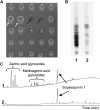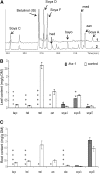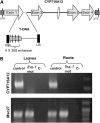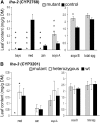Medicago truncatula CYP716A12 is a multifunctional oxidase involved in the biosynthesis of hemolytic saponins
- PMID: 21821776
- PMCID: PMC3180811
- DOI: 10.1105/tpc.111.087312
Medicago truncatula CYP716A12 is a multifunctional oxidase involved in the biosynthesis of hemolytic saponins
Abstract
Saponins, a group of glycosidic compounds present in several plant species, have aglycone moieties that are formed using triterpenoid or steroidal skeletons. In spite of their importance as antimicrobial compounds and their possible benefits for human health, knowledge of the genetic control of saponin biosynthesis is still poorly understood. In the Medicago genus, the hemolytic activity of saponins is related to the nature of their aglycone moieties. We have identified a cytochrome P450 gene (CYP716A12) involved in saponin synthesis in Medicago truncatula using a combined genetic and biochemical approach. Genetic loss-of-function analysis and complementation studies showed that CYP716A12 is responsible for an early step in the saponin biosynthetic pathway. Mutants in CYP716A12 were unable to produce hemolytic saponins and only synthetized soyasaponins, and were thus named lacking hemolytic activity (lha). In vitro enzymatic activity assays indicate that CYP716A12 catalyzes the oxidation of β-amyrin and erythrodiol at the C-28 position, yielding oleanolic acid. Transcriptome changes in the lha mutant showed a modulation in the main steps of triterpenic saponin biosynthetic pathway: squalene cyclization, β-amyrin oxidation, and glycosylation. The analysis of CYP716A12 expression in planta is reported together with the sapogenin content in different tissues and stages. This article provides evidence for CYP716A12 being a key gene in hemolytic saponin biosynthesis.
Figures









Similar articles
-
Sapogenin content variation in Medicago inter-specific hybrid derivatives highlights some aspects of saponin synthesis and control.New Phytol. 2015 Apr;206(1):303-314. doi: 10.1111/nph.13162. Epub 2014 Nov 18. New Phytol. 2015. PMID: 25406544
-
CYP72A67 Catalyzes a Key Oxidative Step in Medicago truncatula Hemolytic Saponin Biosynthesis.Mol Plant. 2015 Oct 5;8(10):1493-506. doi: 10.1016/j.molp.2015.06.003. Epub 2015 Jun 12. Mol Plant. 2015. PMID: 26079384
-
CYP716A subfamily members are multifunctional oxidases in triterpenoid biosynthesis.Plant Cell Physiol. 2011 Dec;52(12):2050-61. doi: 10.1093/pcp/pcr146. Epub 2011 Oct 28. Plant Cell Physiol. 2011. PMID: 22039103
-
Biosynthesis of triterpenoid saponins in plants.Adv Biochem Eng Biotechnol. 2002;75:31-49. doi: 10.1007/3-540-44604-4_2. Adv Biochem Eng Biotechnol. 2002. PMID: 11783842 Review.
-
Key enzymes of triterpenoid saponin biosynthesis and the induction of their activities and gene expressions in plants.Nat Prod Commun. 2010 Jul;5(7):1147-58. Nat Prod Commun. 2010. PMID: 20734961 Review.
Cited by
-
The Sg-1 glycosyltransferase locus regulates structural diversity of triterpenoid saponins of soybean.Plant Cell. 2012 May;24(5):2123-38. doi: 10.1105/tpc.111.095174. Epub 2012 May 18. Plant Cell. 2012. PMID: 22611180 Free PMC article.
-
High-yield bioactive triterpenoid production by heterologous expression in Nicotiana benthamiana using the Tsukuba system.Front Plant Sci. 2022 Aug 18;13:991909. doi: 10.3389/fpls.2022.991909. eCollection 2022. Front Plant Sci. 2022. PMID: 36082301 Free PMC article.
-
Enhanced Salt Tolerance of Rhizobia-inoculated Soybean Correlates with Decreased Phosphorylation of the Transcription Factor GmMYB183 and Altered Flavonoid Biosynthesis.Mol Cell Proteomics. 2019 Nov;18(11):2225-2243. doi: 10.1074/mcp.RA119.001704. Epub 2019 Aug 28. Mol Cell Proteomics. 2019. PMID: 31467032 Free PMC article.
-
Comparative transcriptome analysis to identify putative genes involved in carvacrol biosynthesis pathway in two species of Satureja, endemic medicinal herbs of Iran.PLoS One. 2023 Jul 7;18(7):e0281351. doi: 10.1371/journal.pone.0281351. eCollection 2023. PLoS One. 2023. PMID: 37418504 Free PMC article.
-
OSC2 and CYP716A14v2 catalyze the biosynthesis of triterpenoids for the cuticle of aerial organs of Artemisia annua.Plant Cell. 2015 Jan;27(1):286-301. doi: 10.1105/tpc.114.134486. Epub 2015 Jan 9. Plant Cell. 2015. PMID: 25576188 Free PMC article.
References
-
- Achnine L., Huhman D.V., Farag M.A., Sumner L.W., Blount J.W., Dixon R.A. (2005). Genomics-based selection and functional characterization of triterpene glycosyltransferases from the model legume Medicago truncatula. Plant J. 41: 875–887 - PubMed
-
- Bialy Z., Jurzysta M., Mella M., Tava A. (2006). Triterpene saponins from the roots of Medicago hybrida. J. Agric. Food Chem. 54: 2520–2526 - PubMed
-
- Gamas P., de Billy F., Truchet G. (1998). Symbiosis-specific expression of two Medicago truncatula nodulin genes, MtN1 and MtN13, encoding products homologous to plant defense proteins. Mol. Plant Microbe Interact. 11: 393–403 - PubMed
MeSH terms
Substances
Associated data
- Actions
- Actions
- Actions
Grants and funding
- BB/E01772X/1/BB_/Biotechnology and Biological Sciences Research Council/United Kingdom
- BBS/B/1356X/BB_/Biotechnology and Biological Sciences Research Council/United Kingdom
- BB/I001271/1/BB_/Biotechnology and Biological Sciences Research Council/United Kingdom
- BB/E022758/1/BB_/Biotechnology and Biological Sciences Research Council/United Kingdom
- G17764/BB_/Biotechnology and Biological Sciences Research Council/United Kingdom
LinkOut - more resources
Full Text Sources
Other Literature Sources
Molecular Biology Databases

